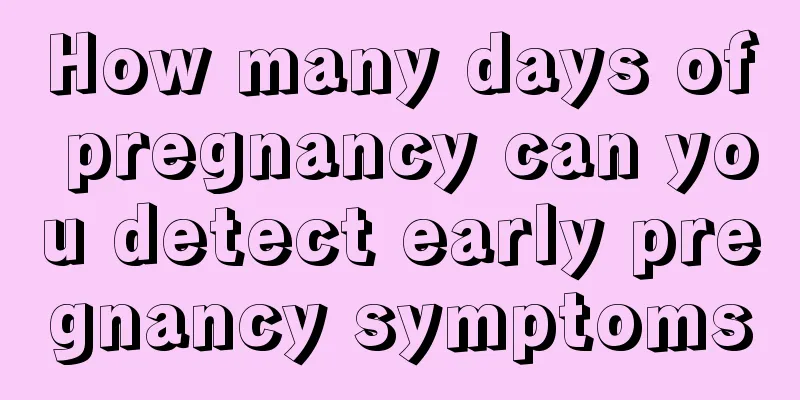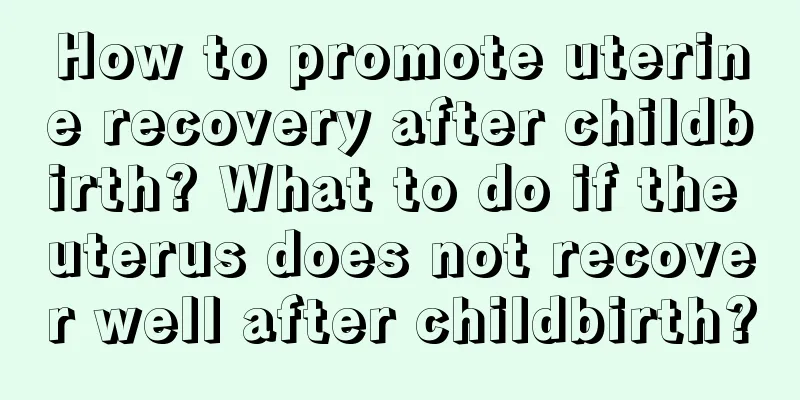How many days of pregnancy can you detect early pregnancy symptoms

|
Some young couples are still very inexperienced when it comes to pregnancy. Today, let’s learn together how many days it takes to detect pregnancy and what the early symptoms of pregnancy are. How many days can pregnancy be detected?Generally speaking, you can test yourself 7-10 days after sex. You can use early pregnancy test strips or pregnancy test sticks to test morning urine for pregnancy. The longer the time after sex, the more accurate it is. In short, you can test whether you are pregnant one week at the earliest and about 3 weeks at the latest after sex. Generally speaking, in the early stages of pregnancy, women will experience a series of early pregnancy reactions such as dizziness, nausea, drowsiness, and breast swelling. Generally, they become more obvious 10-14 days after pregnancy and disappear on their own after three months. Therefore, if a woman has the above symptoms, she can use early pregnancy test strips and pregnancy test sticks to test for pregnancy. However, there are still some women who may not feel obvious in the initial stage or feel very similar to before menstruation and mistakenly think that menstruation is coming soon. Early pregnancy symptomsGenerally speaking, in the early stages of pregnancy, women will experience a series of early pregnancy reactions such as dizziness, nausea, drowsiness, and breast swelling. These symptoms usually become more obvious 10-14 days after pregnancy and disappear on their own after three months. Therefore, if women experience the above symptoms, they can use early pregnancy test strips and pregnancy test sticks to test for pregnancy. Several major characteristics of early pregnancy1. Amenorrhea. Healthy women of childbearing age and with a history of sexual life usually have regular menstrual cycles. If their menstrual periods are overdue, they should consider whether they are pregnant. If their periods are overdue for more than 10 days, they should be highly suspected of pregnancy. 2. Early pregnancy reaction. Symptoms such as dizziness, fatigue, drowsiness, lack of appetite, aversion to greasy food, nausea, and vomiting in the morning appear around 6 weeks after menstruation. These are called early pregnancy reactions. Some pregnant women may also have mood changes. Most of them disappear on their own around 12 weeks after menstruation. 3. Frequent urination. This is caused by the forward-tilted and enlarged uterus pressing on the bladder in the pelvic cavity. When the uterus enlarges beyond the pelvic cavity, the symptom of frequent urination disappears naturally. 4. Breast changes. Breast pain. Examination shows that the breast volume gradually increases, veins are clearly visible, the nipple is enlarged, the nipple and areola are darkened, and sebaceous glands around the areola proliferate and dark brown nodules appear. The milk of lactating women decreases significantly after pregnancy. 5. The vaginal mucosa and the vaginal part of the cervix are purple-blue due to congestion. At 6-8 weeks of pregnancy, the isthmus of the uterus is extremely soft during bimanual examination, and it feels as if the cervix and the uterine body are not connected. The uterus gradually becomes larger and softer, and becomes spherical. At 8 weeks of pregnancy, the uterus is twice as large as that of the non-pregnant state, and at 12 weeks of pregnancy, it is three times as large as that of the non-pregnant state. The fundus of the uterus extends beyond the pelvic cavity and can be touched above the pubic symphysis. 6. Some pregnant women experience increased estrogen levels, such as spider nevi, liver palms, skin pigmentation (face, abdominal white line, areola, etc.). Some pregnant women experience uterine contraction pain or discomfort without uterine bleeding, abdominal distension, constipation and other discomforts. Best time to test for pregnancy1. Early pregnancy test detection time Early pregnancy test strips can generally detect pregnancy two weeks after intercourse, and the urine tested is preferably morning urine. The test will be more accurate if the menstruation is delayed for 5-10 days. Use early pregnancy test strips to check whether you are pregnant. If the test strip shows two red lines, it means you are pregnant, otherwise you are not pregnant. 2. Ultrasound examination time The time for B-ultrasound detection of early pregnancy is generally about one week after the menstruation is delayed. You can go to the hospital for a B-ultrasound examination to see if you are pregnant. If you can see a pregnancy halo under the B-ultrasound, it means you are pregnant. The main purpose of B-ultrasound examination in early pregnancy is to confirm intrauterine pregnancy, exclude ectopic pregnancy and trophoblastic disease, estimate gestational age, and exclude pelvic masses or uterine abnormalities. Generally, a gestational sac can be seen in the uterine cavity 35 days after the menstruation stops; at 6 weeks of pregnancy, the embryo and primitive heart tube pulsation can be seen. |
<<: Electronic products have a great impact on children's growth, so avoid addiction
Recommend
Is it really useful to go to a beauty salon to get a facial?
Nowadays, many beautiful women like to go to beau...
Ofmom Runermei infant formula milk powder is the best choice for enhancing baby's self-protection ability
Babies are the apple of every family's eye. P...
At what age is it normal for children to speak? Why don't children speak?
My child is almost one year old, but he still doe...
What services are included in a doula delivery? Does a doula delivery require an episiotomy?
Before giving birth, many mothers heard that the ...
What should I do if my baby cries and has a bloated stomach?
Since babies cannot express themselves verbally, ...
What is the effect of pregnant women vomiting blood on the fetus? The difference between pregnant boys and pregnant girls
At present, many people want to know whether the ...
What are the symptoms of autism in children and how to treat it
Although a polite child who doesn't run aroun...
Is it better to have fluoride or non-fluoride toothpaste? How to choose the best toothpaste?
Toothpaste is a common item in our daily life. We...
Do you regret having only one child?
In the past, people only had one child under the ...
How long after taking medicine can a baby drink milk? How long after taking medicine can a baby drink milk powder?
Babies are weak and easily get sick. How to feed ...
How to choose rice cereal for four-month-old babies? Rice cereal is the first choice for iron supplementation
Iron-supplemented rice noodles are the first choi...
When your baby is learning to speak, you must have not noticed these three taboos!
Learning to speak is a very important step in a b...
What's going on when my baby suddenly refuses to drink breast milk? Why does my baby refuse to drink breast milk?
What happens if the baby suddenly refuses to eat ...
At what age can babies drink pasteurized milk? Is it good for babies to drink pasteurized milk?
Fresh milk contains a variety of nutrients. You c...
What should I do if my milk supply suddenly decreases after one month? Why does my milk supply decrease after one month?
Many women will have many different situations af...









